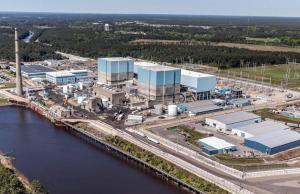
Hurricane Florence no threat to nuclear power plants

Satellite image of Hurricane Florence
Nuclear power has once again withstood threats from Mother Nature.
Hurricane Florence, which battered the U.S. East Coast in September, was worse than predicted.
“Many of the dire predictions came true,” wrote Grist magazine reporter Eric Holthaus. “In the past few days, Hurricane Florence has become the worst rainstorm in history for North Carolina, as well as the entire East Coast.”
The four-day rainfall accumulation of nearly 36 inches, which was measured in Elizabethtown, North Carolina, is above the previous record for a hurricane anywhere on the East Coast. It broke the North Carolina record by nearly a foot.
In the lead-up week before Florence made landfall, the media was full of stories about how as many as nine nuclear reactors could be in its path.
According to Bloomberg News, out of the nine nuclear plants that were potentially in the path of Florence before the storm landed Friday, just one was forced to close.

Brunswick nuclear power plant in North Carolina
The Brunswick nuclear facility was the only one taken offline because of the Hurricane.
While there were concerns about access to the plant due to flooding in the wake of Florence, the U.S. Nuclear Regulatory Commission issued a statement on September 18, to reassure the public about the situation.
“The plant’s two units remain shut down in a safe condition, and flooding in nearby areas has not affected the plant site,” the statement read. “While there are still some site access issues, it is possible to move personnel and supplies to and from the site. Access to the plant is expected to improve over the next couple of days.”
This is the second year in a row that nuclear power plants were tested in the U.S. South during hurricane season.
Last year, Florida’s two nuclear power plants withstood the fury of Hurricane Irma. Turkey Point and St. Lucie nuclear power plants which serve approximately 1.5 million customers are designed to withstand the natural force of such extreme events like hurricanes. Florida’s nuclear plants sit approximately 20 feet above sea level and are constructed to withstand the force of severe flooding and storm surges. Backup safety systems are also in place to ensure site safety.
Concerns about nuclear power plants being affected by hurricanes makes great headlines, but because of preparedness, problems are averted.
Ted Kury, director of energy studies at the University of Florida’s Public Utility Research Center, explained it best in a piece for The Conversation.
“To prevent accidents, the outer wall of reactor containment systems are made out of reinforced concrete and steel,” he wrote. “Since they are designed to withstand the impact of a large commercial airliner, flying debris – even if it’s propelled by 200 miles-per-hour winds – is unlikely to pose much of a threat.”
According to Kury, utilities prepare for storms by inspecting power stations, securing equipment, testing backup pumps and generators and stocking critical supplies in case workers have to stay on site.

